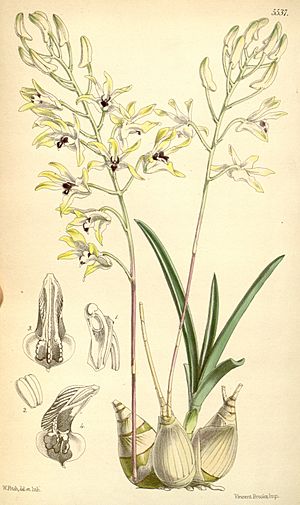Brown tea tree orchid facts for kids
Quick facts for kids Brown tea tree orchid |
|
|---|---|
 |
|
| Illustration from Curtis's Botanical Magazine | |
| Scientific classification | |
| Genus: |
Dendrobium
|
| Species: |
canaliculatum
|
| Synonyms | |
|
|
The Dendrobium canaliculatum, also known as the brown tea tree orchid or thin tea tree orchid, is a special type of orchid. It often grows on other plants or rocks, not in the soil. This orchid has unique cone-shaped or onion-shaped stems called pseudobulbs. It can have up to six dark green leaves that have deep grooves.
Its flowers are star-shaped and can be light brown, caramel, white, greenish, or even apricot in color. The tips of the flowers are usually darker. You can find this beautiful orchid growing in tropical North Queensland in Australia and in New Guinea.
What Does It Look Like?
The Dendrobium canaliculatum is a plant that grows on trees or rocks. It has stems called pseudobulbs that look like cones or onions. These pseudobulbs are about 30–120 mm (1–5 in) long and 10–30 mm (0.4–1 in) wide. Each pseudobulb has two to six leaves on top.
The leaves are dark green and have deep channels or grooves. They are about 100–250 mm (4–10 in) long and 6–12 mm (0.2–0.5 in) wide. The orchid produces a flowering stem that is about 200–300 mm (8–10 in) long. This stem can hold between five and thirty flowers.
The flowers are light brown to caramel-colored and last a long time. They have a pleasant smell. Each flower is about 20–25 mm (0.79–0.98 in) long and 25–30 mm (0.98–1.2 in) wide. The sepals and petals of the flower are twisted near their ends. The sepals are about 10–15 mm (0.4–0.6 in) long. The petals are shaped like spatulas and are about 13–18 mm (0.5–0.7 in) long.
The labellum (the special lip petal of an orchid) is white with purplish marks. It is about 10–13 mm (0.4–0.5 in) long and has three parts, called lobes. The two side lobes curve upwards. The middle lobe has three wavy ridges. This orchid usually blooms between August and November.
Naming the Orchid
The Dendrobium canaliculatum was first officially described in 1810. This was done by a famous botanist named Robert Brown. He published its description in his book, Prodromus Florae Novae Hollandiae et Insulae Van Diemen.
The second part of its scientific name, canaliculatum, comes from a Latin word. It means "channelled" or "grooved," which describes the deep grooves in its leaves.
There are two main types, or varieties, of this orchid:
- Dendrobium canaliculatum var. canaliculatum: This is the brown tea tree orchid. It usually grows on small trees in woodlands, grassy forests, and near streams. You can find it on the Cape York Peninsula in Australia and in southern New Guinea.
- Dendrobium canaliculatum var. foelschi: This is the thin tea tree orchid. It is smaller than the first variety in all its parts. Its flowers are white with yellow or tan tips. This variety grows in coastal areas, often on a tree called the freshwater mangrove (Barringtonia acutangula). It is found in northern parts of the Northern Territory, Queensland (including some Torres Strait Islands), and the Kimberley region of Western Australia.

